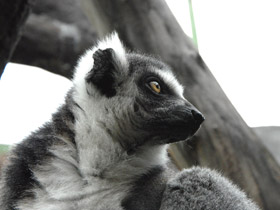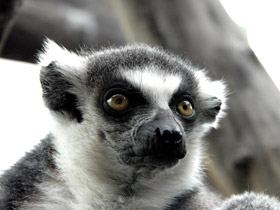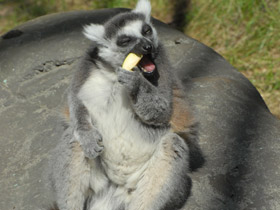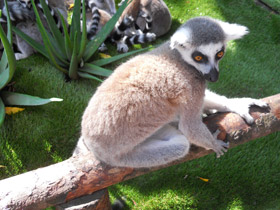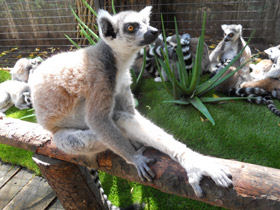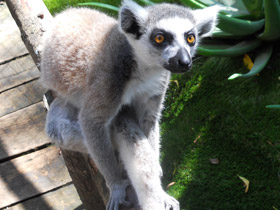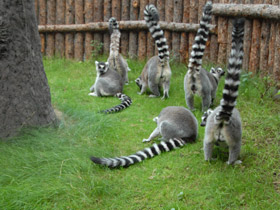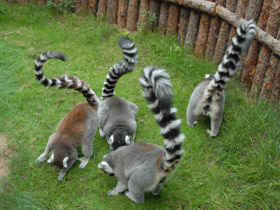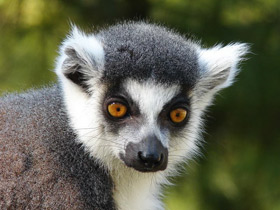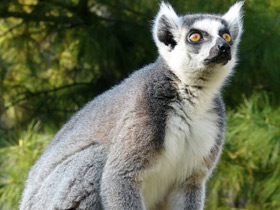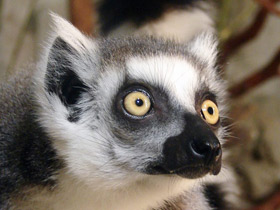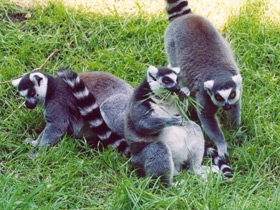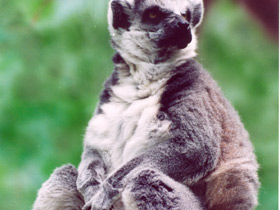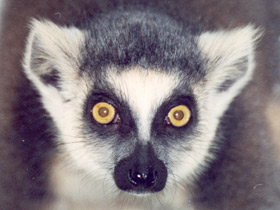The ring-tailed lemur (Lemur catta)
 The ring-tailed lemur (Lemur catta) is included in the IUCN Red List as an endangered species
The ring-tailed lemur (Lemur catta) is included in the IUCN Red List as an endangered species
The ring-tailed lemur (Lemur catta) is a medium- to larger-sized strepsirrhine (wet-nosed) primate, and the most internationally-recognized lemur species, owing to its long, black-and-white, ringed tail. It belongs to Lemuridae, one of five lemur families, and is the only member of the Lemur genus. Like all lemurs, it is endemic to the island of Madagascar, where it is endangered. Known locally in Malagasy as maky ([makʲ], spelled maki in French) or hira, it ranges from gallery forests to spiny scrub in the southern regions of the island. It is omnivorous, as well as the most adapted to living terrestrially of the extant lemurs.
Description and lifestyle
The ring-tailed lemur (Lemur catta), also called the ring-tailed maki, is a species of strepsirrhine primate in the family Lemuridae. The ring-tailed lemur is the only species within the monotypic genus Lemur.
The ring-tailed lemur (Lemur catta) is probably one of the most beautiful and probably best known of the lemurs of Madagascar. The most memorable feature of its appearance is its long tail striped with 14 white and 14 black stripes.
These magnificent tails are visible from far away and help the animals to stay in sight. This is very important for them, as catta lemurs are social creatures and live in groups of up to 30 animals. Catta lemurs have a social structure unique among mammals: the adult females dominate the males and get subordinate behaviour from the adult males, often without any aggression. Each group of feline lemurs has its own territory, which the animals mark with urine and secretions from skin glands on the inside of their forearms. The core group consists of a dominant female with her offspring and one or more subordinate males.
Unlike many lemurs, catta lemurs are diurnal and spend much of their time on the ground. They live in deciduous forests and dry open spaces covered with shrubs. The catta lemur can walk long distances on the ground, moving only on its hind legs or on all four limbs. Here they feed by picking up fallen fruit or gathering berries, grass and leaves with their forelegs. However, the catta lemur also feels very good in trees and can jump five metres.
Reproduction
Females breed annually, with a gestation period of approximately 220 days and a single offspring weighing 80-120 grams at birth. The newborn is covered with fur and has open eyes. The mother carries it with her on her belly for the first week, and then it is carried on her back. At 1-2 months of age, the calf begins to leave the female's back and makes independent forays, returning to the mother during sleep and feeding. At 5-6 months of age, the young become virtually independent. Young females tend to stay with their mothers and sisters, while young males move on to other groups. Females reach sexual maturity at 20 months and males at two and a half years.
Catta lemurs in a zoo
The group of catta lemurs has been kept in the Moscow Zoo since 1980. During this time, the animals have reproduced repeatedly, and have now reached their third generation in captivity. For more than 10 years, scientists have been conducting regular observations of catta lemurs, and for each animal a detailed life history is known, along with all its likes and dislikes. Within the lemur group, friendly alliances (called "bonds") of two to three individuals are clearly visible. The members of the alliance stick together and always help each other in everything. All other members of the group "know" that they cannot harm an individual with impunity, as they will have to take care of their friend as well. The presence of bonded individuals should be taken into account and, if possible, never separate their members, as this is very stressful for the lemurs.









